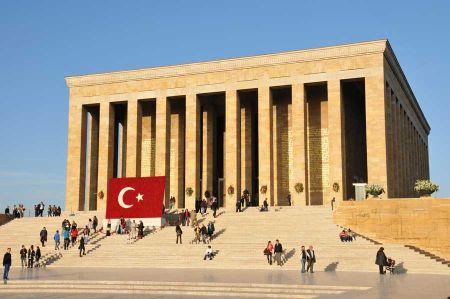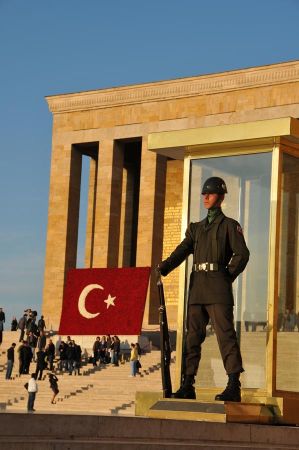Atatürk Mausoleum "Anıtkabir" at burial mound of Phrygians
- Written by Portal Editor
This time our journey was to take us to Ankara, because while looking for a used vehicle we followed two advertisements that seemed so interesting that the trip could be worthwhile.
Of course, we wanted to use the time to look around Ankara a bit, so we set off towards Manavgat at around 7:00 a.m. after a quick breakfast.
Shortly before Manavgat we turned right towards Konya. And as always on this route, we were fascinated by the wonderful views of the Taurus Mountains. Thanks to the excellent road we passed Konya shortly afterwards and then drove on an almost empty route towards Ankara. At the height of Tuz Gölü (salt lake) we stopped for a second breakfast in a restaurant with typical Turkish soup, Gözleme and tea. Despite the sunshine it was already quite cold here on the Anatolian plateau.
Buying a car - On the way to Ankara
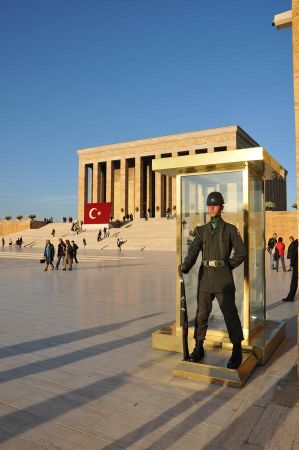 We called the vehicle suppliers and agreed on the bus terminal as the meeting point.
We called the vehicle suppliers and agreed on the bus terminal as the meeting point.
A decision was made shortly afterwards and so we drove to one of the well-known cafes near the Atatürk Mausoleum to negotiate the next steps in taking over the vehicle. We quickly came to an agreement with the really nice, open-minded couple and were then able to take a quick tour of the Atatürk Mausoleum.
The drive through the city was already enormously impressive, absolutely clean with beautiful green spaces. So when we walked through the park by the mausoleum, we were no longer so surprised to see beautifully planted beds and magnificently trimmed trees that formed the frame for the Atatürk Mausoleum.
The Atatürk Mausoleum Anıtkabir - dedicated to the father of the Turks
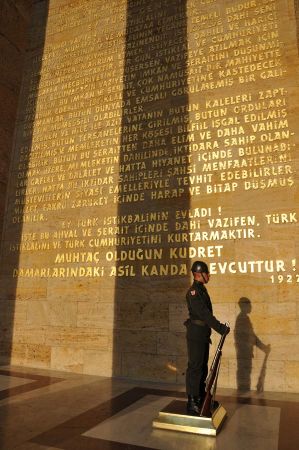 Anıtkabir (Turkish for "grave monument") is the name of the mausoleum of the Turkish state founder Mustafa Kemal Atatürk in Ankara. The grave of Ismet Inönü, the second president of Turkey, is also located in the complex.
Anıtkabir (Turkish for "grave monument") is the name of the mausoleum of the Turkish state founder Mustafa Kemal Atatürk in Ankara. The grave of Ismet Inönü, the second president of Turkey, is also located in the complex.
After his death in 1938, the "Father of the Turks" was initially laid out in the Ethnographic Museum before being buried there after the mausoleum was completed on November 10, 1953, the 15th anniversary of his death.
In December 1938, a parliamentary commission was set up to plan Atatürk's eternal resting place. This decided to announce an international architectural competition and appoint a jury consisting of six architects from four countries, including the German Paul Bonatz.
By the time the competition was completed in March 1942, a total of 49 designs had been submitted, 22 of which were from Turkey. The first prize went to the project by Turkish architects Emin Onat and Orhan Arda. On April 5, 1943, the Turkish National Assembly decided to implement the design by Onat and Arda.
Construction of the monument
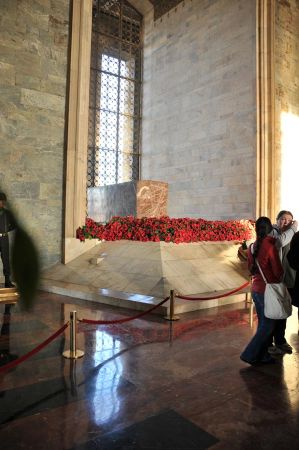 The site is the Rasattepe hill, which was artificially constructed as a burial mound by the Phrygians in the 12th century BC. It was archaeologically examined before construction of the monument began.
The site is the Rasattepe hill, which was artificially constructed as a burial mound by the Phrygians in the 12th century BC. It was archaeologically examined before construction of the monument began.
The finds from the excavation are now on display in the Ethnographic Museum. The hill was only given the name Anıttepe (monument hill) when the tomb for Atatürk was built.
First construction phase
After the plans for the building were finalized, the foundation stone was laid in a ceremonial ceremony on October 9, 1944. The construction work was completed in four stages over a period of nine years.
The construction of the foundation and the retaining walls for the Lions' Path Arslanlı Yol began on the day of the ceremony and lasted until the beginning of 1950.
Second construction phase: 1945–1950
 On September 29, 1945, the construction of the buildings surrounding the festival site began, which lasted until August 8, 1950.
On September 29, 1945, the construction of the buildings surrounding the festival site began, which lasted until August 8, 1950.
At the same time, the statics for the monument were calculated, which was to be made of concrete and stone and not to place too much strain on the foundation. At the end of 1947, the excavation and insulation work was completed and an eleven-meter-high reinforced concrete structure was created for the substructure of the monument.
Entrance towers, paths and roads as well as a tree nursery, the garden and park design and the irrigation system were completed in this phase.
Third construction phase: 1950
The access roads, the Lions' Path, the paving of the festival grounds and the mausoleum floor, the construction of the steps for the stairs and the sarcophagus were carried out in this period.
Fourth construction phase: 1950–1953
In this construction phase (November 20, 1950 – September 1, 1953), the Hall of Honor was equipped and the walls decorated with stone moldings. The vault that supports the large Hall of Honor and which now houses a museum about Atatürk's life's work was built. The Hall of Honor was originally planned to have a vaulted top on pillars. In order to shorten the project, the vault was dispensed with and the building was reduced in size by 28 meters. The ceiling was made flat in reinforced concrete and lined with mosaic on the inside, which also reduced the load on the foundation.
Materials and details
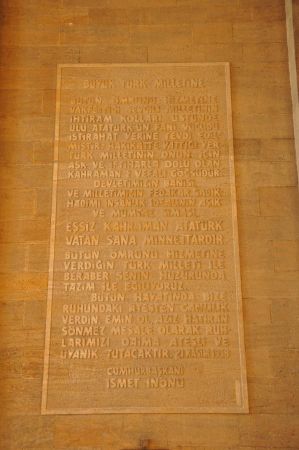 The white travertine for the sculptures, lion figures and columns come from Pınarbaşı (Kayseri), the one inside the towers comes from Polatlı and Malıköy. The victory reliefs, the outer cladding of the Hall of Honor and the pillars of the halls surrounding the fairground were made of yellow travertine from Eskipazar (Çankırı).
The white travertine for the sculptures, lion figures and columns come from Pınarbaşı (Kayseri), the one inside the towers comes from Polatlı and Malıköy. The victory reliefs, the outer cladding of the Hall of Honor and the pillars of the halls surrounding the fairground were made of yellow travertine from Eskipazar (Çankırı).
The cream, red and black marble used to cover the floor in the Hall of Honor comes from Çanakkale, Hatay and Adana, the green marble from Bilecik, the tiger-skin-coloured marble on the walls of the Hall of Honor comes from Afyonkarahisar.
The large stone block for the sarcophagus comes from Osmaniye, its white marble cladding also from Afyonkarahisar.
The black and red stone for the floor of the fairground and towers comes from Boğazköprü (Kayseri).
Atatürk's burial chamber in the Hall of Honor
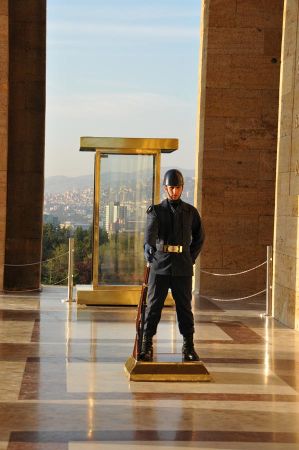 Atatürk's burial chamber is located directly under the Hall of Honor.
Atatürk's burial chamber is located directly under the Hall of Honor.
Atatürk's body is not in a sarcophagus, but directly under the ground. The chamber has an octagonal basic shape and a pyramid-shaped ceiling.
The architecture of the burial chamber is based on the Seljuk-Ottoman tradition of a türbe.
The symbolic sarcophagus is oriented towards Mecca. Vessels are placed around the sarcophagus, containing soil from all provinces of the Republic of Turkey (67 at the time), as well as soil from the Turkish Republic of Northern Cyprus, Azerbaijan, Atatürk's birthplace in Thessaloniki, the Turkish military cemetery in Korea and Süleyman Shah's grave.
The Atatürk Mausoleum - a visitor magnet
 We were particularly impressed by the marble floors and wall panelling, which were laid with absolute precision and perfect craftsmanship. In general, the Atatürk Mausoleum is a magnet for tourists (both local and foreign) and is worth visiting. In the small rooms of the mausoleum, which have been converted into museums, there are a large number of artifacts from the time of Atatürk, but also from modern times. We also found a series of photos of the visit of Federal President Wulf.
We were particularly impressed by the marble floors and wall panelling, which were laid with absolute precision and perfect craftsmanship. In general, the Atatürk Mausoleum is a magnet for tourists (both local and foreign) and is worth visiting. In the small rooms of the mausoleum, which have been converted into museums, there are a large number of artifacts from the time of Atatürk, but also from modern times. We also found a series of photos of the visit of Federal President Wulf.
Ankara is also worth a trip, we will definitely be back.
The Atatürk Mausoleum "Anıtkabir": A modern monument on ancient ground
The Atatürk Mausoleum "Anıtkabir" in Ankara is not only the final resting place of the founder of modern Turkey, Mustafa Kemal Atatürk, but also a place that is deeply rooted in the history of Anatolia. What many people do not know: The mausoleum stands on a burial mound of the Phrygians, an ancient people who lived in this region over 2,500 years ago. This connection between past and present makes Anıtkabir a fascinating place that combines history, culture and national identity.
The Phrygians: An Ancient Heritage
 The Phrygians were a people who created a significant civilization in Central Anatolia between the 12th and 7th centuries BC. They are best known for their elaborate tumuli - large burial mounds that served as the final resting places for their kings and elite. One of these burial mounds is located exactly where Anıtkabir stands today. The choice of this location was no accident: it symbolizes the continuity of Anatolia's history and the connection between the ancient past and modern Turkey.
The Phrygians were a people who created a significant civilization in Central Anatolia between the 12th and 7th centuries BC. They are best known for their elaborate tumuli - large burial mounds that served as the final resting places for their kings and elite. One of these burial mounds is located exactly where Anıtkabir stands today. The choice of this location was no accident: it symbolizes the continuity of Anatolia's history and the connection between the ancient past and modern Turkey.
The Anıtkabir: An architectural masterpiece
Built between 1944 and 1953, Anıtkabir is a stunning example of modern Turkish architecture. The mausoleum's design combines elements of classical Anatolian and Seljuk architecture with modern stylistic elements. The monumental structure, surrounded by symmetrical gardens and sculptures, exudes dignity and respect.
 The main areas of Anıtkabir:
The main areas of Anıtkabir:
1. The Lions' Alley: A wide street lined with stone lion statues that leads to the Court of Honor. The lions symbolize power and peace.
2. The Court of Honor: A large square surrounded by colonnades that contains the symbolic tomb of Atatürk.
1. The Hall of Honor: The centre-piece of the mausoleum, where Atatürk's actual tomb is located. The atmosphere is solemn and poignant.
2. The Museum: Here visitors can view personal items, documents and photographs from Atatürk's life. The museum offers a deep insight into his work and his vision for Turkey.
A place of national identity
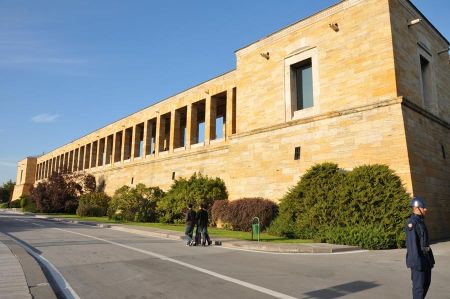 The Anıtkabir is more than just a mausoleum - it is a symbol of modern Turkey. Mustafa Kemal Atatürk led the country through the turbulent years after the collapse of the Ottoman Empire and laid the foundations for a secular, modern republic. The mausoleum is a place of remembrance, but also a place where Atatürk's values and ideals are kept alive.
The Anıtkabir is more than just a mausoleum - it is a symbol of modern Turkey. Mustafa Kemal Atatürk led the country through the turbulent years after the collapse of the Ottoman Empire and laid the foundations for a secular, modern republic. The mausoleum is a place of remembrance, but also a place where Atatürk's values and ideals are kept alive.
Every year, millions of people visit the Anıtkabir to pay their respects to Atatürk. Especially on national holidays such as October 29, Republic Day, people from all parts of the country flock to Ankara to take part in the celebrations.
The connection between ancient and modern
The location of Anıtkabir on a Phrygian burial mound adds an additional historical dimension to this site. It is a reminder that Turkey is built on a rich cultural heritage that stretches back thousands of years. The Phrygians who once ruled this region left their mark - and Anıtkabir now stands as a modern monument on this ancient ground.
A visit to Anıtkabir
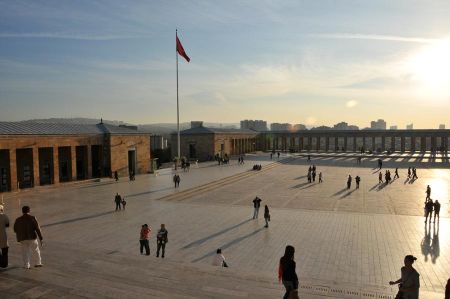 A visit to Anıtkabir is a must for anyone interested in Turkish history and culture. The atmosphere is solemn and respectful, and the architecture is stunning. Those visiting the mausoleum should also plan time for the museum to learn more about the life and work of Atatürk.
A visit to Anıtkabir is a must for anyone interested in Turkish history and culture. The atmosphere is solemn and respectful, and the architecture is stunning. Those visiting the mausoleum should also plan time for the museum to learn more about the life and work of Atatürk.
Conclusion
The Atatürk Mausoleum "Anıtkabir" is not only a place of remembrance, but also a symbol of the connection between the ancient past of Anatolia and modern Turkey. Its location on a Phrygian burial mound underlines the historical depth of this site and makes it a unique place that combines history and modernity. A visit to Anıtkabir is a journey through time - from the ancient Phrygians to the founding of modern Türkiye.
Please read as well:
Beyşehir and the unique wooden pillar mosque
-
 Ankara Anitkabir Mausoleum
Ankara Anitkabir Mausoleum
Ankara Anitkabir Mausoleum
Ankara Anitkabir Mausoleum
-
 Ankara Anitkabir Mausoleum
Ankara Anitkabir Mausoleum
Ankara Anitkabir Mausoleum
Ankara Anitkabir Mausoleum
-
 Ankara Anitkabir Mausoleum
Ankara Anitkabir Mausoleum
Ankara Anitkabir Mausoleum
Ankara Anitkabir Mausoleum
-
 Ankara Anitkabir Mausoleum
Ankara Anitkabir Mausoleum
Ankara Anitkabir Mausoleum
Ankara Anitkabir Mausoleum
-
 Ankara Anitkabir Mausoleum
Ankara Anitkabir Mausoleum
Ankara Anitkabir Mausoleum
Ankara Anitkabir Mausoleum
-
 Ankara Anitkabir Mausoleum
Ankara Anitkabir Mausoleum
Ankara Anitkabir Mausoleum
Ankara Anitkabir Mausoleum
-
 Ankara Anitkabir Mausoleum
Ankara Anitkabir Mausoleum
Ankara Anitkabir Mausoleum
Ankara Anitkabir Mausoleum
-
 Ankara Anitkabir Mausoleum
Ankara Anitkabir Mausoleum
Ankara Anitkabir Mausoleum
Ankara Anitkabir Mausoleum
-
 Ankara Anitkabir Mausoleum
Ankara Anitkabir Mausoleum
Ankara Anitkabir Mausoleum
Ankara Anitkabir Mausoleum
-
 Ankara Anitkabir Mausoleum
Ankara Anitkabir Mausoleum
Ankara Anitkabir Mausoleum
Ankara Anitkabir Mausoleum
-
 Ankara Anitkabir Mausoleum
Ankara Anitkabir Mausoleum
Ankara Anitkabir Mausoleum
Ankara Anitkabir Mausoleum
-
 Ankara Anitkabir Mausoleum
Ankara Anitkabir Mausoleum
Ankara Anitkabir Mausoleum
Ankara Anitkabir Mausoleum
-
 Ankara Anitkabir Mausoleum
Ankara Anitkabir Mausoleum
Ankara Anitkabir Mausoleum
Ankara Anitkabir Mausoleum
-
 Ankara Anitkabir Mausoleum
Ankara Anitkabir Mausoleum
Ankara Anitkabir Mausoleum
Ankara Anitkabir Mausoleum
-
 Ankara Anitkabir Mausoleum
Ankara Anitkabir Mausoleum
Ankara Anitkabir Mausoleum
Ankara Anitkabir Mausoleum
-
 Ankara Anitkabir Mausoleum
Ankara Anitkabir Mausoleum
Ankara Anitkabir Mausoleum
Ankara Anitkabir Mausoleum
-
 Ankara Anitkabir Mausoleum
Ankara Anitkabir Mausoleum
Ankara Anitkabir Mausoleum
Ankara Anitkabir Mausoleum
-
 Ankara Anitkabir Mausoleum
Ankara Anitkabir Mausoleum
Ankara Anitkabir Mausoleum
Ankara Anitkabir Mausoleum
https://www.alaturka.info/en/turkey-country/centralanatolia/6860-atatuerk-mausoleum-an-tkabir-at-the-burial-mound-of-the-phrygians#sigProId4b82e7597d
